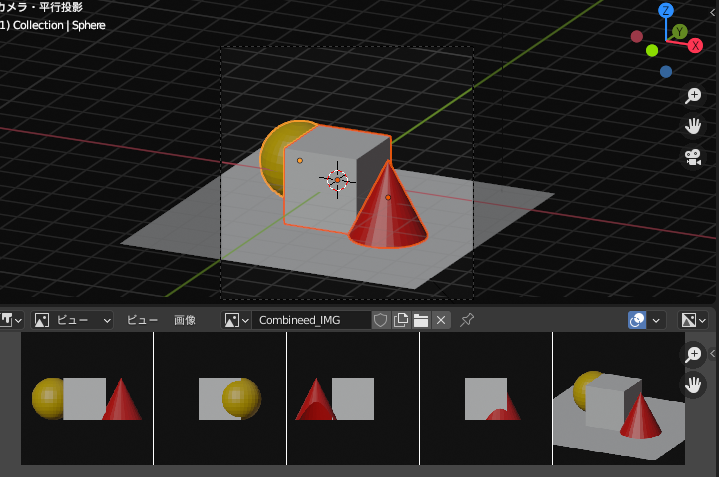Blender Advent Calendar 2020の空き空欄を埋めるため
以前に公開したスクリプトの2.8対応版を記事にしてみます
選択したオブジェクトを前後左右からレンダリングして、
1枚の画像に合成するスクリプトです、

3Dビューで選択している形状が収まるようにカメラの設定を調整して
前後左右平行投影でのレンダリングと 現在のカメラ設定でレンダリングした画像を作成し [Combineed_IMG]という名前で横に並べた画像を作成します
メッシュオブジェクトを選択していないとエラーになるので注意してください
render_around.py
import bpy
import math
import os
import numpy as np
import mathutils
# レンダリングの幅を固定
render_width = 300
# レンダリング画像の保存パス
render_path = bpy.context.scene.render.filepath
def render_func(context):
#シーンで使用しているカメラ
camera = context.scene.camera
if len(context.selected_objects) == 0: return
###############################
###########設定の退避###########
##レンダリングサイズ
render = context.scene.render
ref_render_x = render.resolution_x
ref_render_y = render.resolution_y
ref_render_percentage =render.resolution_percentage
##カメラタイプ(透視投影,平行投影など)
ref_camera_type = camera.data.type
##位置
ref_location = camera.location.copy()
ref_rotate = camera.rotation_euler.copy()
##################################
##オブジェクトモードに
bpy.ops.object.mode_set(mode = 'OBJECT')
#bpy.ops.object.select_all(action="DESELECT")
##################################
##カメラ設定
###レンダリングサイズ
(bbox_width, center_pos) = get_bound_data(context)
set_render_size(context, bbox_width)
#初期状態でレンダリング
bpy.ops.render.render()
#保存
f_name = "view4.png"
seve_render(f_name)
###平行投影
camera.data.type = 'ORTHO'
#平行投影のスケールを設定(幅がBU基準)
camera.data.ortho_scale = max(bbox_width)*1.2
#カメラ位置を(0, -10, 0.3) 回転を(90°, 0, 0)に
camera_pos =get_camera_pos_top(bbox_width, center_pos)
camera.location = camera_pos
camera.rotation_euler = (math.radians(90.0), 0, 0)
#########################################
pos = mathutils.Vector((camera_pos))
mat_rot1 = mathutils.Matrix.Rotation(math.radians(90.0), 4, 'Z')
mat_trs = mathutils.Matrix.Translation(mathutils.Vector(center_pos))
mat_rot = mat_trs *mat_rot1 *mat_trs.inverted()
for i in range(4):
#レンダリング
bpy.ops.render.render()
#保存
f_name = "view%s.png" % i
seve_render(f_name)
#90度回転
pos = mat_rot @ pos
camera.location = pos
cam_rot = (math.radians(90.0), 0, math.radians(90.0)*(i+1))
camera.rotation_euler = cam_rot
##################################
###########設定の書き戻し###########
###レンダリングサイズ
render.resolution_x = ref_render_x
render.resolution_y = ref_render_y
render.resolution_percentage = ref_render_percentage
##カメラタイプ
camera.data.type = ref_camera_type
##位置
camera.location = ref_location
camera.rotation_euler = ref_rotate
#########################################
combine_image(render_path)
# 選択形状から描画範囲のデータを取得(中心点, 幅)
def get_bound_data(context):
objects = context.selected_objects
bb_point_list = []
#選択形状のbbox値をグローバル座標で取得
for obj in objects:
if obj.type != 'MESH':continue
bbox_list = [mathutils.Vector(v[:]) for v in obj.bound_box]
mat = obj.matrix_world
bb_point_list += [mat@v for v in bbox_list]
#範囲を取得
bbox_width = []
center_pos = []
for i in range(3):
min_i = min(bb_point_list, key = (lambda x: x[i]))[i]
max_i = max(bb_point_list, key = (lambda x: x[i]))[i]
bbox_width.append( max_i - min_i )
center_pos.append( (max_i + min_i)/2 )
return(bbox_width, center_pos)
# レンダリングサイズの設定(幅を固定)
def set_render_size(context, bbox_width):
render = context.scene.render
#print(bbox_width)
#縦の長さを取得
render_height = int(render_width*(bbox_width[2]/max(bbox_width[:2])))
if render_height < render_width: render_height = render_width
render.resolution_x = render_width
render.resolution_y = render_height
render.resolution_percentage = 100
# 正面画像レンダリング用のカメラ位置を設定
def get_camera_pos_top(bbox_width, center_pos):
distance = max(bbox_width)
return(center_pos[0], center_pos[1]-distance,center_pos[2])
# 画像の保存
def seve_render(f_name):
img_path = os.path.join(render_path,f_name)
bpy.data.images['Render Result'].save_render(filepath=img_path)
# 画像の読み込み
def load_tex(f_path):
img = bpy.data.images.load(f_path)
return(img)
# rgbaの画像をnparrayに変換
def img_to_nparray(img):
bit_len = len(img.pixels)
(width,height) = img.size
channels = img.channels #色数
#numpy arrayを作成
pixlist = np.array(img.pixels)
pixlist = pixlist.reshape( height, width, 4)
return( pixlist )
# 結合処理
def combine_image(render_path):
width = 0
height = 0
image_list = []
for i in range(5):
f_name = "view%s.png" % i
img_path = os.path.join(render_path,f_name)
img = load_tex(img_path)
image_list.append(img)
width += img.size[0]
height = max(height, img.size[1])
combine_img_np = np.zeros((height, width, 4))
offset = 0
for img in image_list:
#読み込んだ画像をnumpy配列に
np_array = img_to_nparray(img)
(height, width, deps) = np_array.shape
#結合処理
combine_img_np[0:height, offset:offset + width] = np_array
combine_img_np[:,offset] = np.ones(4)
offset += width
#numpy配列からBlender画像データオブジェクトを作成
img_name = 'Combineed_IMG'
(height, width, deps) = combine_img_np.shape
image_object = bpy.data.images.new(name=img_name, width=width, height=height)
image_object.pixels = list(combine_img_np.flatten())
for img in image_list:
bpy.data.images.remove(img)
render_func(bpy.context)
以前のバージョンのものを 2.8以降の対応と多少のバグフィックスをしてあります。